Mayenne to Villaines-la-Juhel
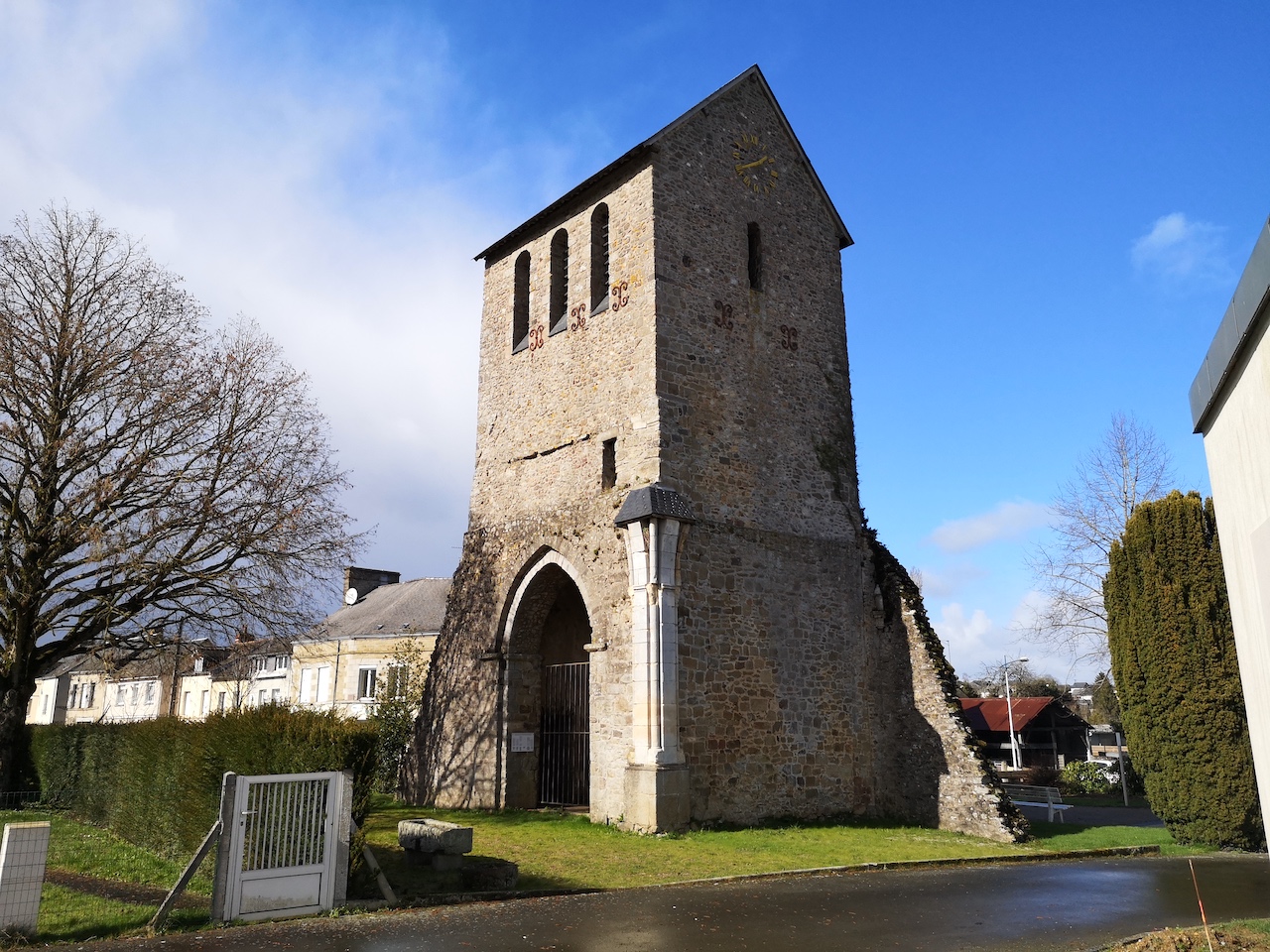
Pays de la Loire
4. Mayenne to Villaines-la-Juhel
Difficult
9h
36,9km
+472m
-374m
Step
Embed this item to access it offline
This route on the Via Columbani is mainly on road, very hilly and uphill to the finish. Caution must accompany you. The archaeological remains of Jublains, the most complete Gallo-Roman site that can be visited in the west of France, will be of interest to walkers passionate about the ancient era.
6 points of interest
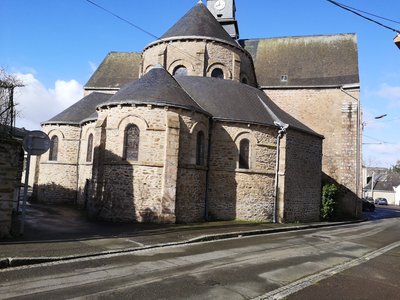
Chevet de l’église Saint-Martin à Mayenne - Amis saint Colomban TouristSaint-Martin Church in Mayenne
According to Abbot Angot, the church was once attached to a monastery and its origins may date back to the 9th century. However, the present church does not predate the 11th century. During the Revolution, the church was closed in 1794 and then converted into a hay barn until 1800, when it reopened. From the Romanesque period, the church has kept its nave, the arms and the transept crossing. The church has an altarpiece from the early 17th century. It is made of wood and its paintings imitate marble to make it look like a Laval altarpiece.
Le site archéologique de Jublains - www.hautemayenne-tourisme.fr HistoricalCounty Archaeological Museum of Jublains.
The museum, opened in 1995. Some of the works exhibited here come from old excavations carried out on the site and from deposits from the Laval or Mayenne museums. The collections on display initially went beyond the framework of the Roman city, extending to archaeological discoveries from the rest of the department, from the earliest prehistoric period to the 16th century. Since then, it has been decided to devote it solely to the Roman period.
Jublains Museum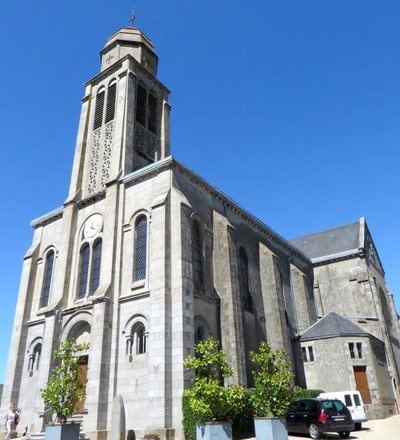
Église Saint-Gervais-et-Saint-Protais à Jublains - http://benjylecter.blogspot.com TouristSaint-Gervais-et-Saint-Protais Church in Jublains
The first Christian building dates back to the 6th or 7th century on the site of Gallo-Roman baths whose walls were destroyed. Its dedication, dating from the Merovingian period, is identical to the cathedral of Le Mans.
The present building dates from the 19th century.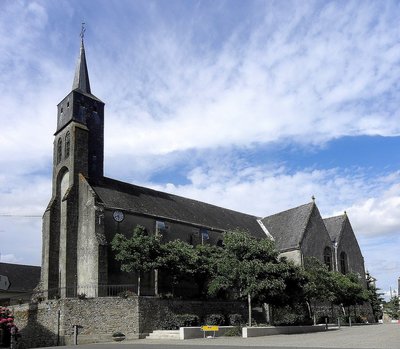
Église Saint-Gervais-et-Saint-Protais à Hambers - Crédit photo : GO69 - Sous Licence Creative Commons TouristChurch of St. Gervais and St. Protais in Hamberss
The church dates from the 12th or 13th century, its Romanesque architecture was reworked in the 15th and 17th centuries. The last stone of the choir was laid in 1684. The exterior peculiarity of the building lies in its bell tower-campanile reinforced with buttresses and an intermediate arch. This type of bell tower is exceptional in the region.
In this church with two altarpieces, one of which is remarkable from the 16th century (PP 53113_3), the light wood Renaissance stalls are simple:
On the back a plant decoration, oak leaves, garlands of leaves.
The seats whose four mercies are decorated with heads, one of which is a pig's head, the armrests are bird's heads and the separations all have small heads.
Source : petit patrimoine.com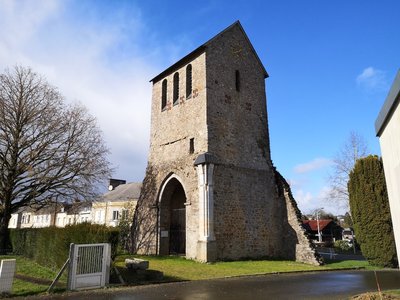
Clocher de l'Ancienne Église Saint-Georges à Villaines-la-Juhel - Amis saint Colomban TouristBell tower of the former St. George's Church
The former St. George's Church was built during the Classical Middle Ages (12th century). Remnant of the former parish church, dedicated to St. George, it was demolished in February 1963 but its bell tower was preserved and restored the same year and it retains its function as a call to prayer with its three bells. The building has a fishbone layout characteristic of its time.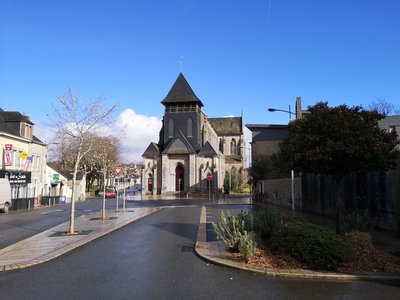
Église Saint-Georges à Villaines-la-Juhel - Amis saint Colomban TouristSaint-Georges Church in Villaines-la-Juhel
The name Villaines could come from the Latin "villa" which corresponds to an isolated agricultural estate. The locality is mentioned in a 7th century manuscript under the name "Vilhena".
Juhel was the name of a family of barons related to the Carolingians who lived in Mayenne and owned a fortress in Villaines, of which only the base of the 11th century keep remains. The Roman road Jublains-Lisieux passed close to the present town.
Neo-Gothic church from the 20th century which replaces the old church. The bell tower on the entrance porch seems to be quite short awaiting a later elevation.
Description
From the church Notre-Dame de Mayenne go down towards La Mayenne to cross it, Notre-Dame bridge, straight on rue Saint-Martin, at the roundabout straight on rue de la Madeleine, at the roundabout second street on the right rue Grinhard, at the crossroads first street on the left rue Saint-Louis, route de Belgeard D 207 E, be careful on this road.
- At the Ancien Bourg de Belgeard, turn right in the direction of La Guesnerie, go straight ahead, turn right at the crossroads with the D7 to Jublains.
- After the cemetery turn right rue du Mur, in front of the archaeological site, left rue de la Libération, at the crossroads straight ahead on the D 129, until the crossroads of Doucé on the right in front of the cross, straight ahead.
- After passing Le Haut Crué in a left bend take a dirt road on the right, straight ahead take the asphalt road on the left D 241, at the crossroads in Hambers turn left onto the D 241 rue des Abbés Gaugain.
- Left at the church crossroads D 236, follow red and white signs, right towards La Pittière, right after the pond cross the hamlet, right at the crossroads of the field paths, cross the road to Bais D 35, follow red and white signs.
- Turn right at the crossroads in front of the pond, follow the red and white signs, straight ahead at each crossroads. At the crossroads with D 237 you leave the red and white beaconing. Stay on the main road, cross the hamlet of Sainte-Marie C3
- At the crossroads straight on rue des Ormeaux, turn left on D 20, in front of the church turn right on rue des Rosiers, after the roundabout turn left on D 239 on the right of the cemetery, straight on the left at the crossroads with D 240, straight on until Villaines-la-Juhel, rue des Coevrons.
- Turn right into rue Saint-Georges and you will arrive at the church Saint-Georges in Villaines-la-Juhel.
- Departure : Notre-Dame-des-Miracles Basilica, Parvis Notre-Dame, 53 100 Mayenne
- Arrival : Saint-Georges Church, 1 rue Gervaiseau, 53 700 Villaines-la-Juhel
- Towns crossed : Pays de la Loire
Altimetric profile
Report a problem or an error
If you have found an error on this page or if you have noticed any problems during your hike, please report them to us here:











